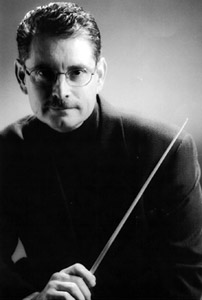![[Metroactive Music]](/music/gifs/music468.gif)
[ Music Index | Santa Cruz Week | SantaCruz Home | Archives ]
 What Is Brahms? The answer is out there, Neo, and it found Larry Granger.
What Is Brahms? The answer is out there, Neo, and it found Larry Granger.
Brahms in Bullet Time SC Symphony stays one step ahead of a challenging program--and waits for the audience to catch up By Scott MacClelland AS CONDUCTOR Larry Granger left the podium and then returned for a curtain call, it was as if the performance he had just orchestrated took several minutes to sink in. At last, a partial standing ovation and a few cheers acknowledged the Santa Cruz Symphony performance of Brahms' Symphony no. 4 last Saturday. The delayed ovation was warranted not only by the quality of the reading, but by the accumulated and unabashed energy and zeal that overtook the musicians. Major credit must go to Granger for the kind of magic that he--more than any other conductor--has been able to work with this orchestra. And this in the face of formidable obstacles--some inherent to the community's resources, some erected by Granger himself. The Santa Cruz Civic Auditorium, for all its concert adjustments, remains at heart a basketball court. Its acoustic curve is opposite the ideal for symphonic music, with exaggerated bass and treble and diminished midrange. Add a large audience--like Saturday's--and potential resonance is reduced further. Also, this performance was a one-off; the orchestra had no second chance to come through. As if that weren't enough, Granger chose a tough program, not least for the stylistic light years that separate Falla's El Amor Brujo from the Brahms symphony. The Falla is a highly detailed, fantastical score with disproportionate emphasis on solos, exotic combinations and disjointed episodes. The Brahms, one of that composer's most complex formal works, requires extraordinary ensemble discipline if it is to succeed.
Upcoming Dates: A rundown of the remainder of the SC Symphony's 2002-2003 season.
In the face of this program (which also included three orchestral songs of no small craft by Copland), the musicians gave the Falla a worthy effort, tempered by a certain self-conscious reticence. The acoustics added their glare of transparent scrutiny, with results neither as exacting nor as powerful as the score wanted. Both pluses and minuses reflected on the conductor, suggesting that a later position in the program might have found the players warmed and more confident. The Falla also asks for a flamboyant and impulsive--in short, Mediterranean--spirit from the podium, something of a stretch for the fastidious Granger. Mezzo-soprano Layna Chianakas did in fact supply Mediterranean animas with abundant character and lustiness. She alternately gleamed and growled as demanded by the text, underscoring each phrase with sensual allure. However, nothing called more attention to the acoustic shortfall of the Civic Auditorium than her unamplified voice, which at times was inaudible to some corners of the room. This is not her fault, and a slight electronic enhancement at the venue makes sense (although it would not be needed at the acoustically efficient Mello Center in Watsonville or smaller Music Hall at UCSC). With only a couple of individual glitches in the opening movement of the Brahms, the orchestra bloomed into its glory, confronting then besting the room's inadequacies and delivering a near-recording-quality performance. The inverted acoustic curve was put right as the inner voices swelled into full sonority. Again, credit must go to Granger for his ever-increasing technical command. He not only memorized the piece (his usual practice) but obviously gave much thought to its syntactical and expressive design. To fulfill that goal, he gave his players vividly clear direction, shaping phrases, balancing sections and cueing entrances. This articulation from the podium is crucial to empowering the musicians and raising both their standards and his. Through challenge and discipline, Granger's art continues to grow and, simultaneously, gain increasing recognition statewide for the Santa Cruz Symphony. [ Santa Cruz Week | Metroactive Central | Archives ]
|
From the November 6-13, 2002 issue of Metro Santa Cruz.
Copyright © Metro Publishing Inc. Maintained by Boulevards New Media.
![[line]](/gifs/line.gif)